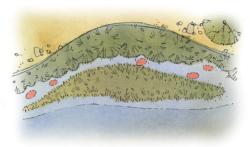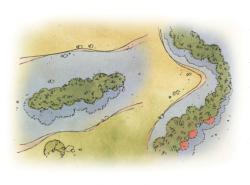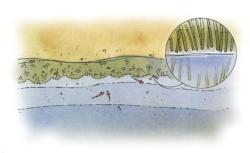Breaking down the tule wall
To enter the house of Western bass, sometimes you have to knock down the barricades first

They might appear as innumerable masses of swaying stalks, but the tules common to Western fisheries such as Clear Lake and the California Delta present multiple opportunities for bass anglers. Moreover, consistent success requires an awareness of multiple strategies and some knowledge of how to break through the tule wall and into the house of the bass that dwell within.
Science of Tules
Pronounced “too-lee,” this durable plant with round green stems has wispy grass-like leaves bearing clusters of light brown flowers. It joins other sedges in the Cyperaceae family.
Newgrowth tules might barely reach a bass boat console, while established populations can tower a dozen feet over the waterline. At any height, tules benefit the fishing scene by filtering water, buffering shorelines, harboring multiple forage species, and offering bass the shelter and feeding opportunities they actively seek.
From Clear Lake’s sprawling fields of swaying shoreline stalks to the Cal Delta’s high “tule berms,” the predictably random composition stands ever diverse. Tules sprouting from rocky shorelines or the Delta’s abundant riprap levees grow in thick walls, while those rooted in mud along contoured shorelines typically present a more featured profile with lots of pockets, points and drains.
The variety of forms taken on by tules requires an equally varied arsenal of tactics and lures. Several top West Coast pros offer their suggestions.
Interior Space
 Sean Minderman, who won the 2011 EverStart Series Western Division event on the Cal Delta, spends much of his springtime hunting spawners in areas where thick submerged grass grows adjacent to tule berms. The key to this scenario is finding the grass growing a couple of feet off the tules, rather than directly alongside them.
Sean Minderman, who won the 2011 EverStart Series Western Division event on the Cal Delta, spends much of his springtime hunting spawners in areas where thick submerged grass grows adjacent to tule berms. The key to this scenario is finding the grass growing a couple of feet off the tules, rather than directly alongside them.
“There are tules on the bank, and then you have weeds,” says Minderman, of Spokane, Wash. “You’re looking for a space between the two. The males will move into those areas and make the nests, and then the females will move into those areas to feed or spawn.”
Delta tides demand consideration here. Fish need sufficient depth to inhabit these spots, but too much water makes them hard to see.
In Clear Lake, where depth remains relatively constant, anglers find sparse tule fields a welcome spawning-season alternative to the narrow and easily crowded creeks and sloughs. Quietly nose into the outer stalks and look for distinct open spots where bass have sufficient nesting space with quick escape routes to deep water. It’s the same scenario, but in slightly different areas. Weightless Yamamoto Senkos, drop-shots and Texas-rigged lizards usually meet with enthusiastic response.
Dark Side of the Tule
 When targeting tule islands, or any angled shoreline, pro Matt Newman of Agoura Hills, Calif., pays close attention to the orientation of tule pockets and the tules exposed to the sun. Gaps in the vegetation present prime bass lounges, but just like manmade real estate, it’s all about location, location, location. He has found that the pockets and indentations darkened by shadows are the hottest locales.
When targeting tule islands, or any angled shoreline, pro Matt Newman of Agoura Hills, Calif., pays close attention to the orientation of tule pockets and the tules exposed to the sun. Gaps in the vegetation present prime bass lounges, but just like manmade real estate, it’s all about location, location, location. He has found that the pockets and indentations darkened by shadows are the hottest locales.
“You might look at a line of tules and think it’s all the same, but there’s always a spot that bass like,” Newman says. “In the morning, you might find a consistent bite along one side of the tules, but in the afternoon those areas will slow down because the shadows have shifted. Fish the other side of tule islands and you’ll often find that the fish have relocated to the new shadow pockets.”
Deep Drop
 When fishing the deep sloughs and channels networking across the Cal Delta, Alameda, Calif., pro Zack Thompson knows that although his drop-shot might land in 6 inches of water when he casts it next to a tule clump, a plunge of 6 feet or more might be within a worm’s length away. These deep banks are good target areas for a tule pattern.
When fishing the deep sloughs and channels networking across the Cal Delta, Alameda, Calif., pro Zack Thompson knows that although his drop-shot might land in 6 inches of water when he casts it next to a tule clump, a plunge of 6 feet or more might be within a worm’s length away. These deep banks are good target areas for a tule pattern.
Bass will follow high tides right up to the tules and into any gaps within sparse vegetation. Outgoing water finds the fish sliding off the shallow ledges of tule growth and into the adjacent depths. Thompson uses the mud lines on tule stalks to gauge water level and likely fish location – up in the tules at high water and off into the depths at low water.
Frog Fancy
Western frog pro Ish Monroe might occasionally work his namesake Snag Proof Ish’s Phat Frog roughly parallel to the tules, but he expects greater opportunities by casting or pitching his amphibian imposter into specific nooks and notches. These target zones are small, so Monroe maximizes his opportunity with a specific presentation.
 “I call it walking the dog in place,” he says. “You want to make a cast to the pocket and leave the frog in the pocket by working it for a longer period of time. Giving the fish time to find it is what triggers a lot of strikes.”
“I call it walking the dog in place,” he says. “You want to make a cast to the pocket and leave the frog in the pocket by working it for a longer period of time. Giving the fish time to find it is what triggers a lot of strikes.”
Pointing his rod tip at the frog creates slack in the line, so Monroe’s rod movements don’t advance the frog forward as it “walks.” Short twitches create the same nose-up walking appearance as a traditional retrieve, but the frog remains on the fish’s radar longer.